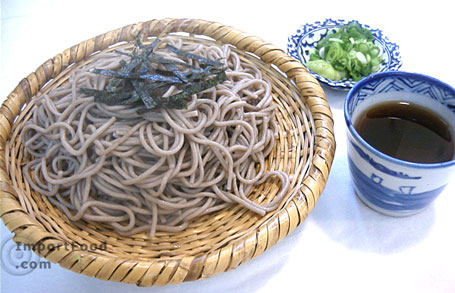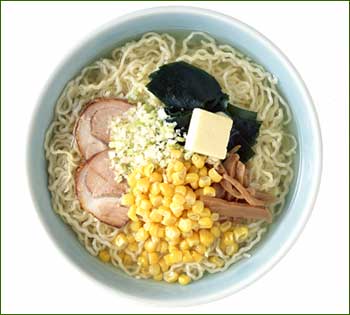Using One's Noodle
In a comment on the last post, Selba asked me about the difference between udon and ramen. I started to write a reply offering an explanation, but as it got longer I realized I had an idea for a new post. Indeed, noodles are an important part of the Japanese diet, so the topic definitely merits some exploration. Anyway, the most common varieties of Japanese noodle are:
1. Udon

A bowl of "tanuki (raccoon dog) udon". Image from Japan's World.
Udon is a relatively simple, wheat-based noodle which is also noted for its thickness. As it is somewhat bland in flavor and easy to digest, it is often recommended as a gentle food for people with upset stomachs (and I heartily agree). However, it is also widely popular as a regular dish. There are many popular ways of serving udon, most of which involve the noodles served in a hot broth together with ingredients such as chopped scallions, herbs, mushrooms, wakame (kelp), or eggs. It is also common to eat it cold, particularly in the summer.
It is widely believed that udon was introduced to Japan by Kukai, a Buddhist priest of the Heian Era (late 8th to 11th century), after he returned from a trip to China. He brought with him a recipe for a Chinese noodle, known as cu mian, which was even bigger, actually more like a dumpling, but over time it came to be udon as it is now known.
2. Soba

Zaru (drained) soba. Image from Import Food.
Soba noodles are made from combinations of different kinds of flour, but the main ingredient (at least 30% by law) is soba (蕎麦 - buckwheat), which gives them their characteristic grayish color. They are usually somewhat larger in diameter than spaghetti noodles but still relatively thin and flexible. As with udon, soba noodles are usually eaten in a variety of different dishes combining a broth and a combination of other ingredients. In fact, many if not most traditional udon/soba dishes are interchangeable. Chilled soba is also highly popular, particularly drained soba noodles dipped in soy sauce (zaru soba). There is also a popular fast-food dish called yakisoba which consists of a special variety of soba noodles and various vegetables and/or meat fried on a griddle. The buckwheat flour used to make soba noodles gives them a stronger flavor than most other types, but they are also said to be much higher in fiber content and thus healthier.
It may be interesting to note that, as soba is relatively easy to make, it is not uncommon to have "soba parties" in which the guests start with a ball of raw soba dough and make their own noodles. I can personally vouch for the fact that it's a lot of fun!
The origin of soba noodles is unclear. It is widely believed that they came from the Yunan area of China, but it is known that people were eating them in Japan at least during the Nara Era (710-794) if not earlier.
3. Sōmen

Five different varieties of sōmen. Image from the Ehime Prefecture tourist information website.
Sōmen (そうめん) are very thin, delicate noodles made from wheat flour. They are distinct from udon and other wheat noodles not only for their size but also for the fact that they are stretched rather than measured and cut. Sōmen is usually served chilled as a summer dish, sometimes in cold broth or soy sauce, sometimes drained. There are many varieties available, some of which incorporate special flavorings.
The origin of sōmen is unclear (most likely China), but locally-made varieties were popular gift items in Kyoto and Osaka as far back as the Azuchi-Momoyama Era (1568-1603).
4. Ramen

A bowl of shio (clear-broth) ramen. Image from Just Hungry.
The term "ramen" properly refers to a dish consisting of boiled noodles, meat, and possibly other ingredients served in a meat broth mixed with meat or fish stock and possibly either miso or soy sauce. It is considered a Chinese food in Japan, and its origin is undoubtedly Chinese, but yet there is no direct traditional equivalent in China (and even the etymology of the word "ramen" is a subject of much debate!). It is unclear when and how it first appeared in Japan, but it came to be popular in the Chinatowns of both Yokohama and Kobe during the Meiji Era (1868-1912).
There are many varieties of noodle used to make ramen, many if not most of which are local specialties. For example, the famous ramen noodles of Sapporo have a somewhat different flavor and color from the also-famous variety native to Asahikawa. A connoisseur can taste a bowl of ramen and identify what part of Tokyo or Yokohama it has come from, and if he's good enough he might even be able to name the restaurant. At any rate, many localities have their own style of ramen noodles, and the natives tend to hold them with great pride. Not surprisingly, the ingredients in the noodles are often a closely-guarded secret, but all of them are based on wheat flour, salt, water, and carbonated mineral water that may also contain phosphoric acid. They range in color from yellowish-brown to bright yellow.
Unlike the other types of noodle I have described here, ramen noodles are normally only used to make ramen, i.e. boiled noodles in a meat broth. However, there are many, many, many varieties of ramen, and new types are invented every year. And then of course there is the oh-so-familiar instant ramen...
There are other kinds of noodles to be found here, but these are the big ones (not counting spaghetti), so I'll leave it here.
Oh, now I've done it. My stomach is GROWLING...
1. Udon

A bowl of "tanuki (raccoon dog) udon". Image from Japan's World.
Udon is a relatively simple, wheat-based noodle which is also noted for its thickness. As it is somewhat bland in flavor and easy to digest, it is often recommended as a gentle food for people with upset stomachs (and I heartily agree). However, it is also widely popular as a regular dish. There are many popular ways of serving udon, most of which involve the noodles served in a hot broth together with ingredients such as chopped scallions, herbs, mushrooms, wakame (kelp), or eggs. It is also common to eat it cold, particularly in the summer.
It is widely believed that udon was introduced to Japan by Kukai, a Buddhist priest of the Heian Era (late 8th to 11th century), after he returned from a trip to China. He brought with him a recipe for a Chinese noodle, known as cu mian, which was even bigger, actually more like a dumpling, but over time it came to be udon as it is now known.
2. Soba

Zaru (drained) soba. Image from Import Food.
Soba noodles are made from combinations of different kinds of flour, but the main ingredient (at least 30% by law) is soba (蕎麦 - buckwheat), which gives them their characteristic grayish color. They are usually somewhat larger in diameter than spaghetti noodles but still relatively thin and flexible. As with udon, soba noodles are usually eaten in a variety of different dishes combining a broth and a combination of other ingredients. In fact, many if not most traditional udon/soba dishes are interchangeable. Chilled soba is also highly popular, particularly drained soba noodles dipped in soy sauce (zaru soba). There is also a popular fast-food dish called yakisoba which consists of a special variety of soba noodles and various vegetables and/or meat fried on a griddle. The buckwheat flour used to make soba noodles gives them a stronger flavor than most other types, but they are also said to be much higher in fiber content and thus healthier.
It may be interesting to note that, as soba is relatively easy to make, it is not uncommon to have "soba parties" in which the guests start with a ball of raw soba dough and make their own noodles. I can personally vouch for the fact that it's a lot of fun!
The origin of soba noodles is unclear. It is widely believed that they came from the Yunan area of China, but it is known that people were eating them in Japan at least during the Nara Era (710-794) if not earlier.
3. Sōmen

Five different varieties of sōmen. Image from the Ehime Prefecture tourist information website.
Sōmen (そうめん) are very thin, delicate noodles made from wheat flour. They are distinct from udon and other wheat noodles not only for their size but also for the fact that they are stretched rather than measured and cut. Sōmen is usually served chilled as a summer dish, sometimes in cold broth or soy sauce, sometimes drained. There are many varieties available, some of which incorporate special flavorings.
The origin of sōmen is unclear (most likely China), but locally-made varieties were popular gift items in Kyoto and Osaka as far back as the Azuchi-Momoyama Era (1568-1603).
4. Ramen

A bowl of shio (clear-broth) ramen. Image from Just Hungry.
The term "ramen" properly refers to a dish consisting of boiled noodles, meat, and possibly other ingredients served in a meat broth mixed with meat or fish stock and possibly either miso or soy sauce. It is considered a Chinese food in Japan, and its origin is undoubtedly Chinese, but yet there is no direct traditional equivalent in China (and even the etymology of the word "ramen" is a subject of much debate!). It is unclear when and how it first appeared in Japan, but it came to be popular in the Chinatowns of both Yokohama and Kobe during the Meiji Era (1868-1912).
There are many varieties of noodle used to make ramen, many if not most of which are local specialties. For example, the famous ramen noodles of Sapporo have a somewhat different flavor and color from the also-famous variety native to Asahikawa. A connoisseur can taste a bowl of ramen and identify what part of Tokyo or Yokohama it has come from, and if he's good enough he might even be able to name the restaurant. At any rate, many localities have their own style of ramen noodles, and the natives tend to hold them with great pride. Not surprisingly, the ingredients in the noodles are often a closely-guarded secret, but all of them are based on wheat flour, salt, water, and carbonated mineral water that may also contain phosphoric acid. They range in color from yellowish-brown to bright yellow.
Unlike the other types of noodle I have described here, ramen noodles are normally only used to make ramen, i.e. boiled noodles in a meat broth. However, there are many, many, many varieties of ramen, and new types are invented every year. And then of course there is the oh-so-familiar instant ramen...
There are other kinds of noodles to be found here, but these are the big ones (not counting spaghetti), so I'll leave it here.
Oh, now I've done it. My stomach is GROWLING...



10 Comments:
Wow!!! Thanks so much for this post explaining about all kind famous noodles in Japan! Very interesting...
Now, my stomach is also growling, hehehe....
By Selba, at 9:08 AM
Selba, at 9:08 AM
You know what? I got a conclusion which is all kind of noodles in this world are originally from China. Even the famous Italian noodle (read: spaghetti) was brought by Marco Polo from China, if I'm not mistaken.
Btw, what is kelp? It looks like seaweed.
By Selba, at 9:39 AM
Selba, at 9:39 AM
What's even more surprising is that the overwhelming majority of Japanese noodles are based on wheat flour, whereas pasta based on rice flour is much more common in Italy!
By The Moody Minstrel, at 2:34 PM
The Moody Minstrel, at 2:34 PM
Kelp is a kind of seaweed.
Yum, had cold udon today. Soba is a favorite of mine. And nothing like a hot bowl of ramen with lots of veggies, mushroom, and an egg on a cold day. Well, actually, all those noodles are great, including spaghetti.
By Pandabonium, at 9:37 PM
Pandabonium, at 9:37 PM
I don't care for the ramen soups or soba recipes including cinnamon, but I do like a bowl of spicy udon :)
Because, personally, I find the broth gets in the way of my enjoying the noodles. One exception: I'll happily drink noodle soups when I'm recovering from illness!
By Olivia, at 12:31 AM
Olivia, at 12:31 AM
I guess my level of noodle sophistication is not very high. I usually get the microwaveable type that you can cook in three minutes, and when I am done eating it, I wish I had something else to eat.
By Anonymous, at 1:23 AM
Anonymous, at 1:23 AM
You know, MM, I can't even see the photos you've posted and my stomach is growling! You are a wealth of information on the the noodle front! I like using somen when I need the noodles to cook quickly, kind of like capellini. I always thought ramen was the kind of noodle that's been fried so that it cooks/reconstitutes quickly for "instant" noodles.
By Anonymous, at 1:58 AM
Anonymous, at 1:58 AM
Soba is great on a hot day!
I have to be in the right mood for Udon though because the noodles are so thick and unlike western style noodles.
By Swinebread, at 11:25 AM
Swinebread, at 11:25 AM
Darn, Moody, my stomach is growling too.
A soba-making party--how cool is that?
The somen image is so artful. What delicate, variegated colors. How elegant those little sheaves bound in blue are.
And I know I shouldn't be, but given my limited experience with ramen--those prefab soup mixes here in the US--I was a little surprised to learn of ramen connoisseurs. Surprised in a good way.
By San, at 6:52 AM
San, at 6:52 AM
Time for another post, Minstrel-san!
By Olivia, at 10:41 PM
Olivia, at 10:41 PM
Post a Comment
<< Home